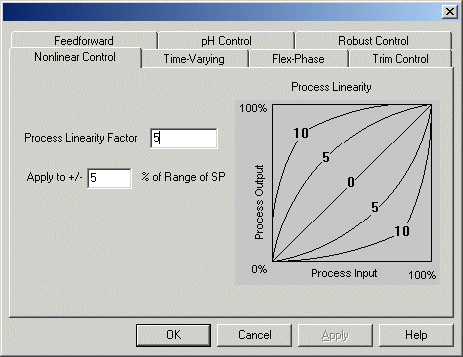| Flow Control
Introduction
When comparing the 4 major process variables: temperature,
pressure, flow, and level, flow is probably the least
difficult to control but has the largest number of loops
because a continuous process is about moving material
flows from the beginning of the process to the end.
Typically, the flow loop is controlled by manipulating
a valve, a variable frequency drive (VFD), or a pump.
Why Flow Control Can Be Difficult
It is relatively easy to control a flow loop because
it is naturally a first-order process with a small delay
time. Since the flow loops are the foundation of a process
control system (for instance, it is typically used as
the inner loop of a cascade control system), their control
performance is critical. Namely, how fast the PV reaches
SP, whether there is an overshoot, how fast the overshoot
damps out, and how fast PV can settle within a desired
range can all be the quality criteria for the flow loop.
In flow control, the commonly used actuators are all
nonlinear components by nature.
1. A control valve is almost never a linear component.
It can have a concave, convex, or S-shaped nonlinear
relationship between its input and output. Some of them
even have hysterisis behavior that makes the problem
much worse.
2. A variable frequency drive (VFD) saves energy but
is naturally a nonlinear device.
3. A flow pump driven by a pulse-width modulator (PWM)
based on the duty cycles does not necessarily have a
linear relationship with the flow.
In addition, the inevitable wear and tear of the actuator
can make the nonlinear behavior worse. Therefore, the
challenge for flow control is mainly how to control
a nonlinear process with stringent control performance
requirements.
MFA Control Solution
The Nonlinear MFA controller is well suited to control
flow for the following reasons:
1. It is a general-purpose controller that provides
a more uniform solution to nonlinear control problems.
2. It requires neither process models nor nonlinear
characterization.
3. It can be easily configured with the parameters listed
in Table 1.
Table 1. Nonlinear MFA as a
Flow Controller
| Nonlinear
MFA Parameter |
Description |
Default
Value |
Fast
Flow |
| Ts |
Sample interval (seconds) |
0.3 seconds |
0.03 seconds |
| Kc |
MFA controller gain |
1.0 |
1.0 |
| Tc |
Process time constant (seconds) |
3 seconds |
0.3 seconds |
| Linearity Factor |
Defines how nonlinear the process is
(0 – linear, 10 – extremely nonlinear)
|
5 |
5 |
| SP Range (%) |
Defines the range for nonlinear control
(0% to 100%)
|
5 |
5 |
As illustrated in the following configuration menu,
when using Nonlinear MFA, the specific characteristics
of the nonlinear curve are not a concern. The curve
can be concave, convex, or S-shaped. Simply advise the
controller whether the process is extremely nonlinear
(enter a 9 or 10), quite nonlinear (enter a 5 or 6),
or somewhat nonlinear (enter an 1 or 2). The Nonlinear
MFA is smart enough to handle the rest.

Simulations and real applications show that Nonlinear
MFA can tightly control various nonlinear flow loops
in the full control range, even when the process gain
changes hundreds of times.
Summary
Based on the core MFA control method, various
MFA controllers have been developed to solve specific
control problems. This applies to flow control applications
as well. The Nonlinear MFA is simply the most effective
and user-friendly flow controller on the market that
is the best candidate to become the next generation
mainstream flow controller.
Case Studies
To read more about implementations of CyboSoft’s
MFA flow control solutions, click on the following case
studies:
Model-Free
Adaptive Control of Steam Drum Level
MFA
Control and Optimization of Gas Mixing Process
|